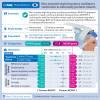Non-invasive high frequency oscillatory ventilation for primary respiratory support in extremely preterm infants: multicentre randomised controlled trial
- PMID: 41052898
- PMCID: PMC12498197
- DOI: 10.1136/bmj-2025-085569
Non-invasive high frequency oscillatory ventilation for primary respiratory support in extremely preterm infants: multicentre randomised controlled trial
Abstract
Objective: To test the hypothesis that non-invasive high frequency oscillatory ventilation (NHFOV) is more efficacious than nasal continuous positive airway pressure (NCPAP) in reducing invasive mechanical ventilation as primary respiratory support for extremely preterm infants with respiratory distress syndrome.
Design: A multicentre, randomised controlled trial.
Setting: Twenty tertiary neonatal intensive care units in China.
Participants: 342 extremely preterm infants (gestational age between 24 weeks +0 day and 28 weeks +6 days) with respiratory distress syndrome were enrolled in the study between August 2022 and August 2024.
Interventions: Participants were randomly allocated to receive NCPAP or NHFOV as primary respiratory support for respiratory distress syndrome.
Main outcome measures: The primary outcome was treatment failure, defined as the need for invasive mechanical ventilation within 72 hours after birth.
Results: Treatment failure within 72 hours occurred in 27 of` 170 infants (15.9%) in the NHFOV group and 48 of 172 infants (27.9%) in the NCPAP group (risk difference -12.0 percentage points, 95% confidence interval -20.7 to -3.4; P=0.007). Treatment failure within seven days was also lower in the NHFOV group (-12.5 percentage points, 95% confidence interval -21.9 to -3.2; P=0.008) compared with the NCPAP group. All observed associations remained significant after sensitivity analysis including study sites and antenatal steroid use. No significant differences were found in any other secondary outcomes between the two groups.
Conclusions: NHFOV appeared superior to NCPAP in reducing the need for intubation when used as a primary respiratory support strategy in extremely preterm infants. Both techniques did not show significant differences in neonatal adverse events.
Trial registration: ClinicalTrials.gov NCT05141435.
© Author(s) (or their employer(s)) 2019. Re-use permitted under CC BY-NC. No commercial re-use. See rights and permissions. Published by BMJ.
Conflict of interest statement
Competing interests: All authors have completed the ICMJE uniform disclosure form at https://www.icmje.org/disclosure-of-interest/ and declare: support from National Key Research and Development Program of China, Natural Science Foundation of Chongqing, Hunan Provincial Clinical Research Center for Newborn Diseases of Maternal Origins, the Chongqing Maternal and Child Disease Prevention and Control and Public Health Research Project, Key Research and Development Program of Jiangxi, Clinical Research Project for the Summit Program of Children’s Hospital of Chongqing Medical University. No financial relationships with any organisations that might have an interest in the submitted work in the previous three years; no other relationships or activities that could appear to have influenced the submitted work.
Figures



References
-
- Stoll BJ, Hansen NI, Bell EF, et al. Eunice Kennedy Shriver National Institute of Child Health and Human Development Neonatal Research Network . Neonatal outcomes of extremely preterm infants from the NICHD Neonatal Research Network. Pediatrics 2010;126:443-56. 10.1542/peds.2009-2959. - DOI - PMC - PubMed
Publication types
MeSH terms
Associated data
LinkOut - more resources
Full Text Sources
Medical
